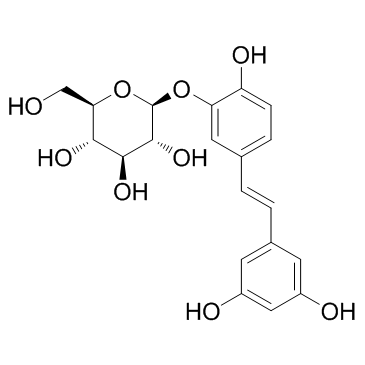94356-26-0
| Name | (2S,3R,4S,5S,6R)-2-(5-((E)-3,5-dihydroxystyryl)-2-hydroxyphenoxy)-6-(hydroxymethyl)tetrahydro-2H-pyran-3,4,5-triol |
|---|---|
| Synonyms |
5-[(E)-2-(3,5-Dihydroxyphenyl)vinyl]-2-hydroxyphenyl β-D-glucopyranoside
5-[(E)-2-(3,5-dihydroxyphenyl)ethenyl]-2-hydroxyphenyl β-D-glucopyranoside β-D-Glucopyranoside, 5-[(E)-2-(3,5-dihydroxyphenyl)ethenyl]-2-hydroxyphenyl Piceatannol 3'-O-glucoside |
| Description | Piceatannol 3'-O-glucoside, an active component of Rhubarb, activates endothelial nitric oxide (NO) synthase through inhibition of arginase activity with IC50s of 11.22 µM and 11.06 µM against arginase I and arginase II, respectively. |
|---|---|
| Related Catalog | |
| Target |
NO synthase[1] IC50: 11.22 μM (Arginase I), 11.06 μM (Arginase II)[1] |
| In Vitro | Piceatannol 3'-O-glucoside (Piceatannol-3'-O-β-D-glucopyranoside; PG) is a potent component of stilbenes, inhibits the activity of arginase I and II prepared from mouse liver and kidney lysates, respectively, in a dose-dependent manner. In human umbilical vein endothelial cells, incubation of Piceatannol 3'-O-glucoside markedly blocks arginase activity and increases nitrite and nitrate (NOx) production, as measured by Griess assay. In liver lysates, incubation of different concentrations of Piceatannol 3'-O-glucoside significantly decreases arginase I activity (75±5% at 1 µM, 72±7% at 3 µM, 62±1% at 10 µM) compared to untreated control (100±9%). In kidney lysates, the residual arginase activities after incubation of 1, 3 and 10 µM Piceatannol 3'-O-glucoside are 75±6, 74±5, and 53±8%, respectively. Arginase activity is measured in the presence of different concentration of Piceatannol 3'-O-glucoside (from 0 to 120 µM) using liver lysate and kidney lysate. The 50% inhibitory concentrations (IC50) are 11.22 µM for the liver lysate and 11.06 µM for kidney lysate. The values are obtained using the software of Graphpad prizm 4.0. Piceatannol 3'-O-glucoside inhibits arginase activity and increases NO production in HUVECs. Piceatannol 3'-O-glucoside inhibits lipoxygenase activity upto 66% at the concentration of 100 µM and IC50 value is 69 µM[1]. |
| In Vivo | In order to ascertain whether Piceatannol 3'-O-glucoside (PG) ameliorates vascular function in wild-type (WT) and atherogenic model mice [apolipoprotein E-null mice (ApoE-/-)] and to investigate the possible underlying mechanism. Preincubation of aortic vessels from WT mice fed a normal diet (ND) with Piceatannol 3'-O-glucoside attenuates vasoconstriction response to U46619 and phenylephrine (PE), while the vasorelaxant response to acetylcholine (Ach) is markedly enhanced in an endothelium-dependent manner. Piceatannol 3'-O-glucoside treatment attenuates the phenylephrine (PE)-dependent contractile response, and significantly improves the acetylcholine (Ach)-dependent vasorelaxation response in aortic rings from ApoE-/- mice fed a high-cholesterol diet (HCD). Piceatannol 3'-O-glucoside administration in the drinking water significantly reduces fatty streak formation in ApoE-/- mice fed an HCD[2]. |
| Kinase Assay | Tissue lysates are prepared using lysis buffer (50 mM Tris-HCl, pH 7.5, 0.1 mM EDTA and protease inhibitors) by homogenization at 4°C followed by centrifugation for 20 min at 14,000× g at 4°C. The supernatants are used to assay for arginase activity. The livers or kidneys from C57BL/6 mice (10 weeks) are homogenized in the buffer (50 mM Tris-HCl, 150 mM NaCl, 1% Nonidet P-40, 1 mM EDTA, 1 µg/mL of leupeptin, 1 µg/mL of pepstatin, 1 µg/mL of aprotinin, 1 mM phenylmethylsulfonylflouride, 1 mM sodium orthovanadate, and 1 mM NaF) and centrifuged for 30 min at 14,000× g. The protein amount of the supernatant is analyzed by the Bradford method. Protein (100 µg) are separated in a 10% SDS-PAGE and then transferred to a nitrocellulose membrane. The blots are incubated with a monoclonal anti-arginase I, anti-arginase II, anti-endothelial nitric oxide synthase (eNOS), or anti-β-tubulin antibodies followed by the secondary antibody. The signals are detected using an enhanced chemiluminescence detection reagent with X-ray films[1]. |
| Animal Admin | Mice[2] Twenty 10-week-old male wild-type (WT) (C57BL/6J) and ApoE-/- mice are studied. To determine the effect of Piceatannol 3'-O-glucoside on vascular reactivity, aortic rings isolated from 20 male C57BL/6J WT mice fed a normal diet (ND) and 20 male ApoE-/- mice fed an HCD are studied for 6 weeks. Aortic rings are incubated with or without Piceatannol 3'-O-glucoside (50 μM) for 18 h. For the pathological assay, Piceatannol 3'-O-glucoside is administered in the drinking water to ApoE-/- mice for 6 weeks when the mice are started on the HCD. Given that each mouse consumes ~10 mL water/day this represents a daily dose of ~500 μg/mouse/day of Piceatannol 3'-O-glucoside[2]. |
| References |
| Density | 1.6±0.1 g/cm3 |
|---|---|
| Boiling Point | 721.6±60.0 °C at 760 mmHg |
| Molecular Formula | C20H22O9 |
| Molecular Weight | 406.383 |
| Flash Point | 390.2±32.9 °C |
| Exact Mass | 406.126373 |
| PSA | 160.07000 |
| LogP | 0.04 |
| Vapour Pressure | 0.0±2.5 mmHg at 25°C |
| Index of Refraction | 1.761 |


